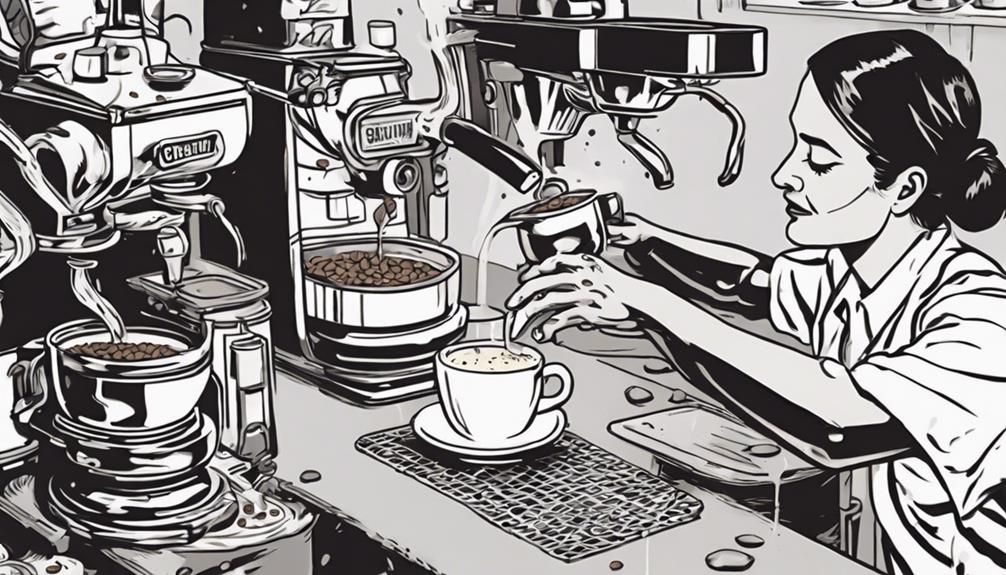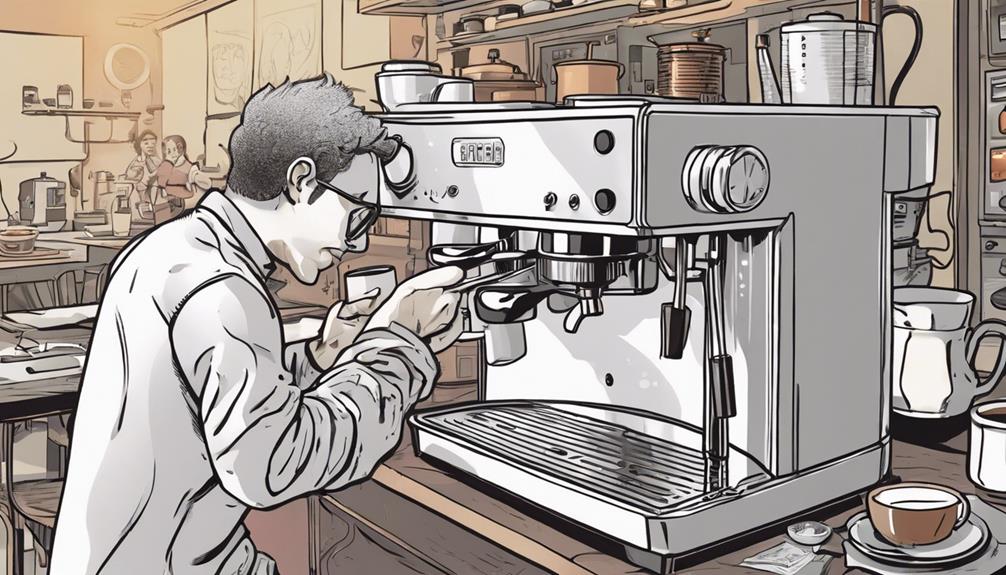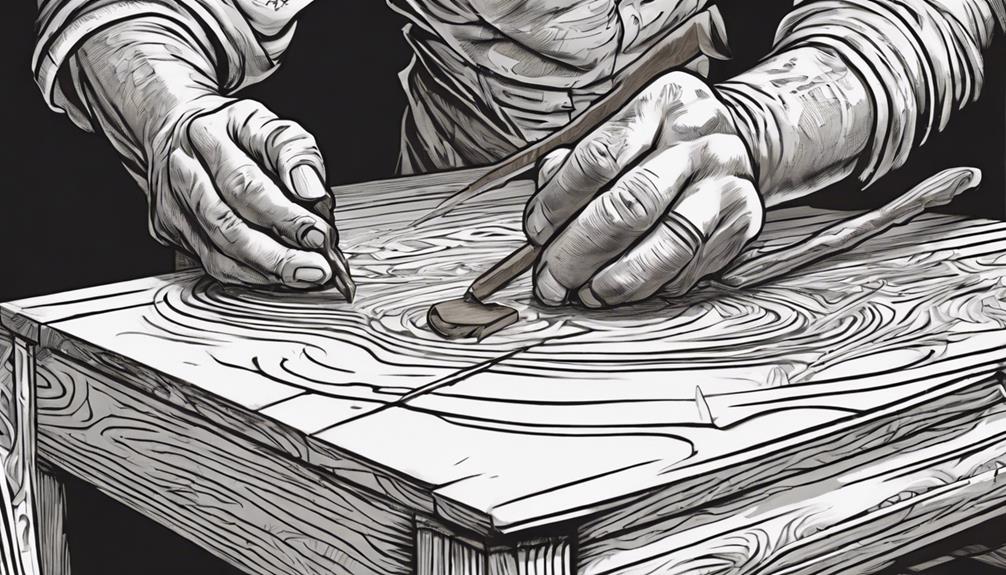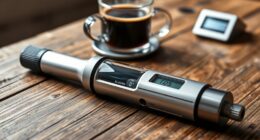To make coffee like a skilled barista, perfect the 25-second espresso extraction. Heat your cup to enhance flavors, sanitize your portafilter, and strive for accurate grinding and measuring. Spread grounds evenly, press with 30 pounds of force, and froth milk beginning cold for ideal consistency. Ensure your equipment is kept clean and serviced regularly for optimal results. Mastering these fundamentals lays the groundwork for top-notch coffee beverages.
Key Takeaways
- Proper grounds distribution for consistent water flow.
- Precise tamping essential for optimal extraction.
- Master milk steaming for enhanced flavor.
- Regular equipment cleaning ensures quality.
- Understand the importance of grind size and dose.
Espresso Extraction Parameters
To extract the perfect espresso, aim for an ideal extraction time of around 25 seconds. This timeframe allows the flavors to develop fully without extracting undesirable compounds that could make the espresso taste bitter.
Along with timing, the grind size and dose play pivotal roles in achieving a balanced and flavorful shot. The grind size is a key factor in espresso extraction. A finer grind increases the surface area of the coffee particles, allowing for more efficient extraction in the allotted time. On the other hand, a coarser grind can result in under-extraction, producing a weak and sour espresso. Adjusting the grind size based on the beans' freshness and roast level can markedly impact the final flavor profile.
In addition to grind size, the dose of dry coffee grounds used also influences the extraction. Typically, a dose of 8-10 grams is recommended for a single espresso shot. However, this can be adjusted based on personal preference and the specific coffee being used. Finding the right balance between grind size and dose is essential for consistently delicious espresso.
Cup Preparation
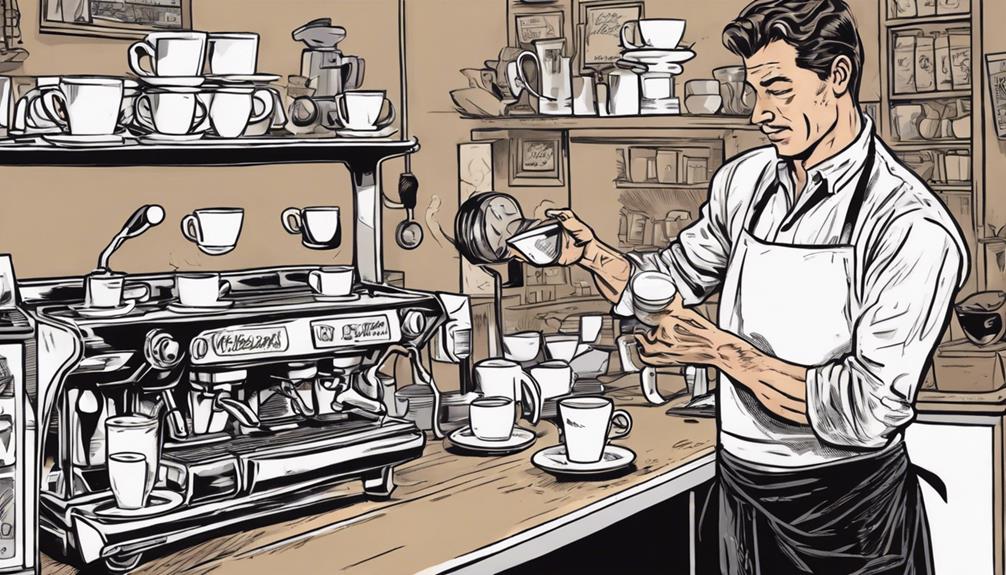
Warm your cup before use by rinsing it with hot water to maintain the best temperature for enjoying the coffee. This important step guarantees that your beverage stays warm for longer, allowing you to savor the flavors and aromas to the fullest.
Here are three essential tips for cup preparation:
- Temperature Maintenance: By warming your cup, you prevent the coffee from cooling down rapidly once poured, preserving its taste profile.
- Enhanced Drinking Experience: Preparing the cup helps maintain the ideal temperature for enjoying your coffee, enhancing your overall drinking experience.
- Industry Standard: It's a common practice in the coffee industry to warm cups before serving espresso. This practice is vital for ensuring that the coffee is served at the perfect temperature for consumption, as desired by coffee enthusiasts and professionals alike.
Portafilter & Basket Care
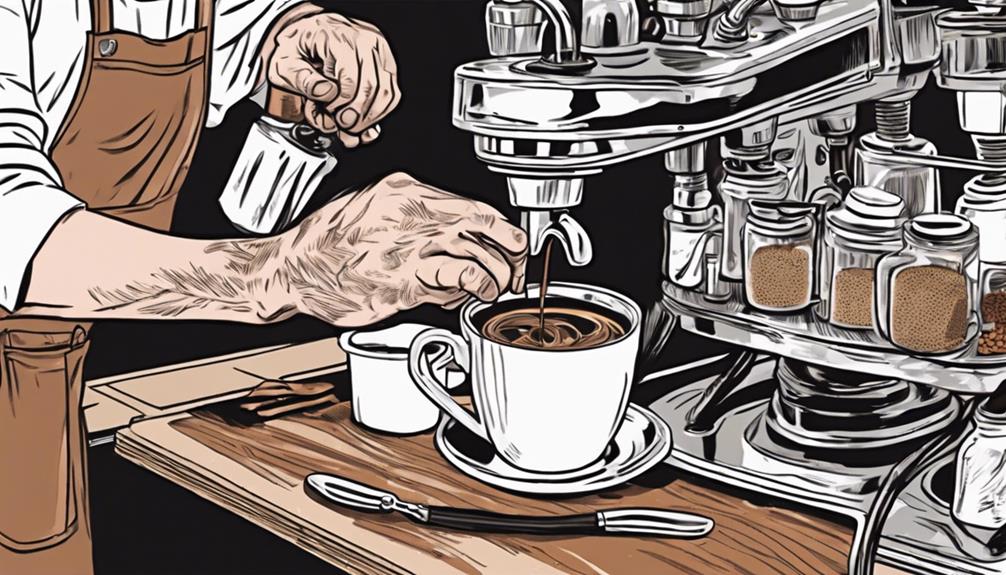
Maintaining a clean and dry portafilter handle is necessary to prevent old coffee residue from impacting the taste of your espresso shots.
When the portafilter handle isn't properly cleaned, the remnants of old coffee can mix with the fresh coffee grounds, leading to an undesirable flavor in your espresso shot.
Additionally, ensuring that the basket is dry before dosing the coffee grounds is important.
A wet basket can impact the extraction process, affecting the quality of the espresso shot.
Moist coffee grounds can also result in poor extraction, highlighting the importance of keeping all components of the portafilter dry.
Remember, old coffee residue in the portafilter can greatly alter the flavor of your espresso shot.
Proper care of the portafilter and basket is essential for achieving consistent and high-quality espresso extractions.
Grind & Dose Technique
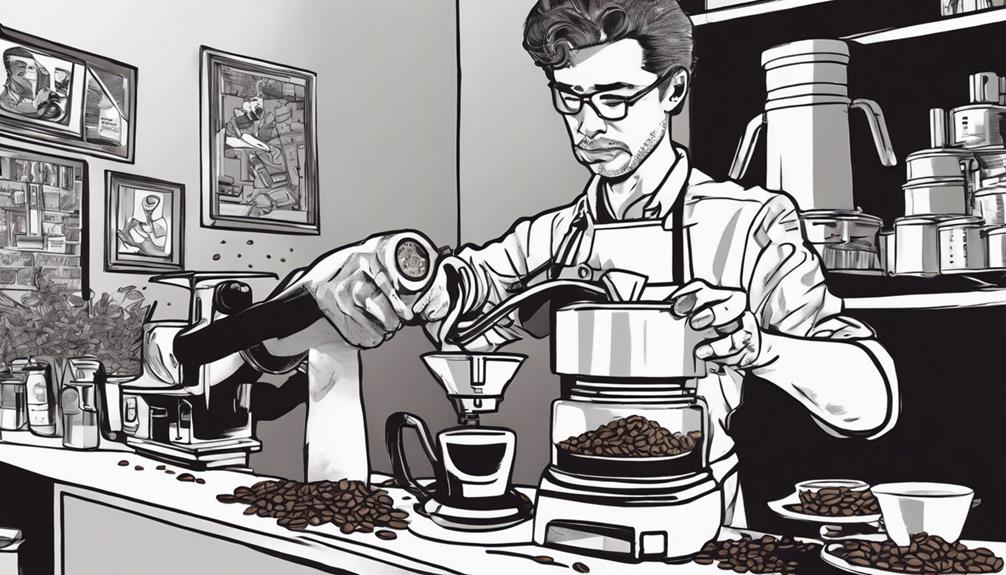
Pay attention to the grind size and dose of coffee beans when making espresso to achieve best flavor extraction.
Using a scale for precise measurement helps achieve consistency in your brews.
Adjusting grind size and dose accurately is important in avoiding over- or under-extraction, guaranteeing a balanced and flavorful shot every time.
Grind Size Importance
Adjusting the grind size for your espresso is necessary for achieving the perfect extraction and flavor profile. The grind size of your coffee beans plays an important role in the extraction rate and taste of your espresso. Here are three key points to keep in mind when it comes to grind size importance:
- Extraction Rate:
Finer grinds lead to a slower extraction process, allowing for more flavor compounds to dissolve into your espresso. Conversely, coarser grinds result in a quicker extraction, which can impact the overall flavor profile.
- Flavor Profile:
Experimenting with different grind sizes can help you fine-tune the taste of your espresso. A consistent grind size is essential for ensuring an even extraction and a well-balanced flavor in every cup.
- Machine Compatibility:
Adjust your grind size based on the capabilities of your espresso machine. Different machines may require slightly different grind sizes to achieve best results. Remember, finding the perfect grind size is a crucial step in mastering the art of making exceptional espresso.
Dosing Accuracy Tips
To optimize your espresso extraction, focus on mastering dosing accuracy through proper grind and dose technique.
When dosing for a single espresso shot, aim for 8-10 grams of dry coffee grounds. Using a scale can help you achieve the perfect amount of coffee for each shot, ensuring consistency in flavor and strength.
It's pivotal to pay attention to both the grind size and dose of coffee to prevent over- or under-extraction during brewing.
Calibrated grinders are handy tools that simplify dosing by providing precise measurements for each shot, aiding in the creation of a balanced and flavorful espresso.
Consistency in Extraction
Achieving consistent extraction in espresso preparation hinges on mastering the grind size and dose of coffee grounds. To optimize extraction uniformity, consider the following tips:
- Grind Size: Adjust the grinder to achieve the right consistency for your espresso machine. Finer grinds increase extraction speeds, while coarser grinds slow it down. Experiment with different settings to find the best size for your desired flavor profile.
- Dose: Use a scale to measure the precise amount of coffee grounds for each shot. Consistent dosing helps maintain a balanced extraction and prevents over- or under-extraction, leading to better-tasting espresso.
- Extraction Uniformity: Pay close attention to the interaction between grind size and dose. Proper calibration of these factors is essential for achieving extraction uniformity and delivering high-quality espresso consistently.
Grounds Distribution Method
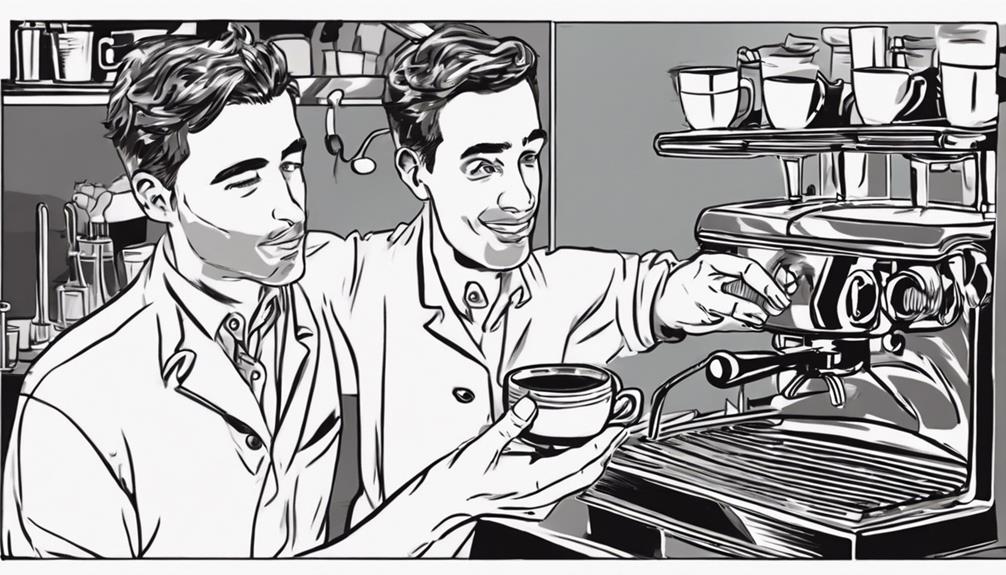
To make espresso like a pro, guarantee even grounds distribution in your portafilter.
Using a distribution tool can help achieve consistency in the coffee bed.
Prevent uneven extraction by mastering the art of grounds distribution.
Even Ground Distribution
For consistent extraction in espresso making, ensuring even ground distribution is essential. When the coffee particles are distributed evenly in the portafilter, water can flow consistently through the coffee bed, leading to a balanced and flavorful shot.
To achieve this, consider the following:
- Tap and Settle: After dosing the coffee grounds into the portafilter, tap the sides of the portafilter handle with your palm to settle the grounds uniformly. This helps in creating a level surface for tamping.
- Use a Distribution Tool: Investing in a distribution tool can further enhance the evenness of the coffee grounds in the portafilter. These tools help in leveling the grounds without disrupting their placement.
- Avoid Channeling: Uneven grounds distribution can result in channeling, where water finds paths of least resistance through the coffee bed. This leads to extraction inconsistencies and can negatively impact the flavor of the espresso shot.
Tool for Grounds
Consider using a distribution tool to achieve even ground distribution in your espresso-making process for consistent and flavorful shots.
A distribution tool assists in evenly spreading coffee grounds within the portafilter, ensuring a uniform extraction. By minimizing the risk of air pockets, which can lead to uneven extraction and impact the espresso's flavor, this tool is essential for precision in brewing.
Specialty coffee shops commonly utilize distribution tools to create a level surface of grounds, facilitating consistent water flow through the coffee bed during extraction. This uniform distribution is crucial for optimizing the extraction process and producing high-quality espresso shots.
Implementing a distribution tool in your espresso routine can help you maintain quality and consistency in every cup you brew, ensuring that each shot is flavorful and well-extracted.
Prevent Uneven Extraction
Achieve even extraction and flavorful shots by focusing on proper grounds distribution techniques, starting with tapping the portafilter handle and utilizing a distribution tool if available. Uneven grounds distribution can lead to channeling, affecting the flavor extraction of your espresso.
To prevent this, follow these steps:
- Tap the Portafilter: After dosing your coffee grounds, tap the portafilter handle gently on the countertop. This helps settle the grounds and removes any air pockets, ensuring a more uniform distribution.
- Use a Distribution Tool: If you have a distribution tool, such as a leveling tool or distribution tool, use it to evenly spread the grounds in the portafilter. This helps achieve a consistent density of coffee grounds for uniform extraction.
- Water Spreads Uniformly: Proper distribution of coffee grounds ensures that water spreads consistently through the coffee bed, extracting flavors evenly. This is essential for a balanced and delicious espresso shot.
Tamping Process
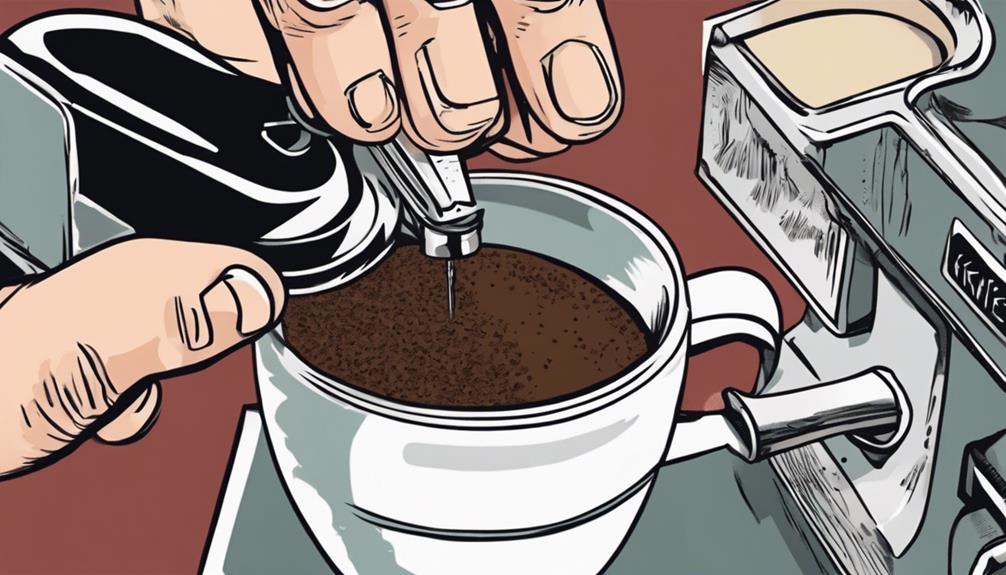
Properly tamping the coffee grounds in the portafilter is essential for achieving an even extraction and balanced espresso shot. Tamping is a pivotal step in the espresso-making process, as it requires applying approximately 30 pounds of force to compress the coffee grounds uniformly. This pressure helps create a level surface in the portafilter, eliminating air pockets and ensuring consistent density for peak extraction.
When tamping, be mindful of the grind size and type of coffee being used, as these factors can influence the ideal tamping pressure. Over-tamping can lead to restricted flow and under-extraction, resulting in a bitter taste, while under-tamping may cause channeling and an uneven extraction, leading to a sour taste in the espresso.
Milk Steaming Essentials
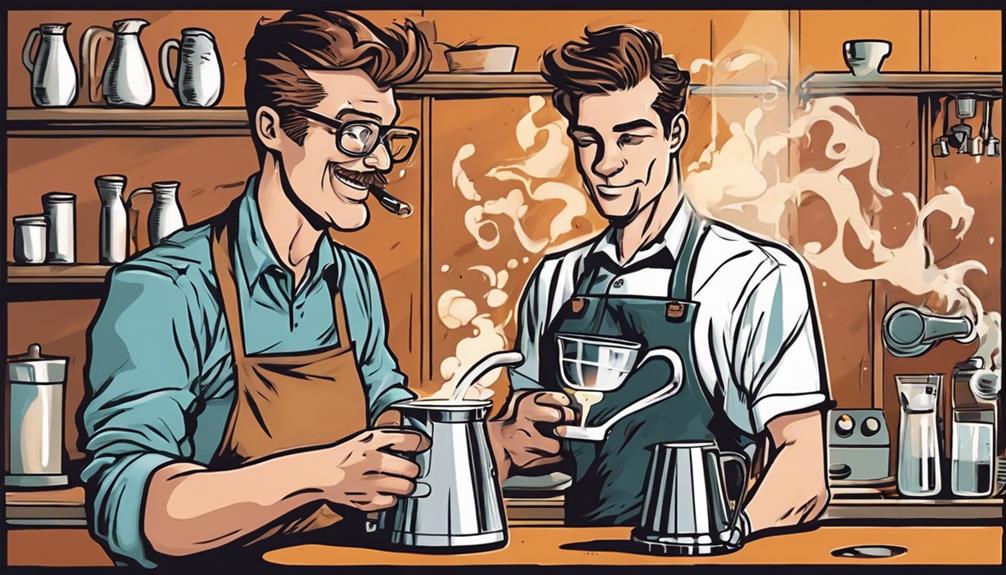
Mastering milk steaming techniques is crucial for enhancing the flavor and sweetness of espresso drinks. To achieve the perfect milk texture, follow these key steps:
- Start with Cold Milk: Using chilled milk, especially with lower-fat content, makes it easier to texture properly. It aids in achieving the ideal consistency for your espresso drinks.
- Use the Correct Pitcher Size: Make sure you have the right-sized pitcher for the amount of milk you're steaming. This allows for better control and manipulation of the milk during the steaming process.
- Introduce Air and Stretch the Milk: When steaming the milk, introduce air up to approximately 100 degrees Fahrenheit. This step helps in creating the desired microfoam texture that enhances the flavor and sweetness of the milk in your espresso beverages.
Equipment Cleaning Guide
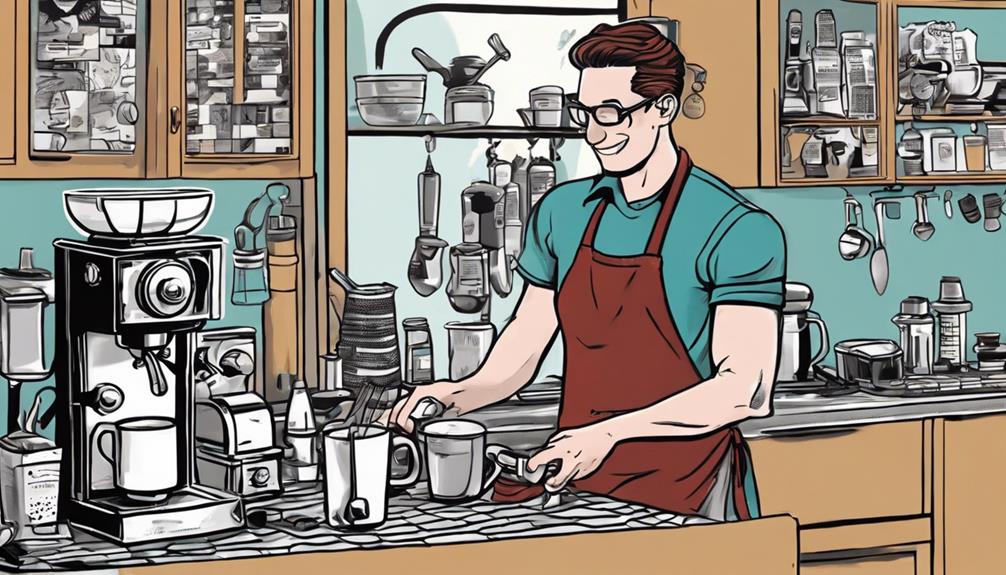
For effective maintenance of your espresso equipment, follow these important cleaning guidelines.
To clean your portafilters and baskets effectively, soak them separately in hot water with espresso machine detergent. This process helps remove any lingering coffee residue and oils.
Additionally, make sure to backflush your espresso machine using a blind filter and EP Clean regularly to eliminate buildup and maintain the quality of your coffee.
Regular maintenance is essential for the longevity of your equipment and the flavor of your brew. Follow the manufacturer's cleaning instructions or utilize built-in cleaning programs for efficient upkeep.
By adhering to a consistent cleaning routine, you guarantee that your equipment functions optimally and produces high-quality coffee.
Lastly, remember to schedule periodic servicing by a trained technician every six months to address any potential issues and keep your espresso machine in top condition.
Proper cleaning is key to brewing exceptional coffee consistently.
Frequently Asked Questions
How to Make a Perfect Barista Coffee?
To make a perfect barista coffee, aim for an extraction time of around 25 seconds, using 8-10 grams of coffee grounds for a single shot. Adjust the volume to 25-35 ml, depending on taste. Factors like roast and grind size are essential.
How Do You Make Coffee Like a Pro?
To make coffee like a pro, you must master the art of precision. Pay attention to every detail: warm your cup, clean the portafilter, grind right, tamp evenly, and distribute properly. Set the stage for perfection!
How Do You Make Coffee Taste Like a Barista?
To make coffee taste like a barista, start with high-quality beans, use a precise coffee-to-water ratio, maintain the water temperature, grind to a medium-fine consistency, and rinse the filter. These steps elevate your coffee game!
How to Be a Barista for Beginners?
To be a barista for beginners, you must embrace the art of coffee like a blank canvas awaiting your brushstrokes. Start by learning coffee types, brewing techniques, and honing your customer service skills for a fulfilling journey ahead.
Conclusion
Now that you've mastered the art of making coffee like a pro barista, you can impress your friends and family with your newfound skills. You can also take your coffee-making game to the next level by learning about coffee grinder burr alignment. This knowledge will allow you to adjust the grind size to perfection, ensuring that each cup of coffee is brewed to its fullest potential. Your friends and family will be amazed at the level of precision and expertise you bring to the table with your coffee-making skills.
Remember, practice makes perfect, so keep honing your techniques and experimenting with different coffee beans to create the perfect cup of coffee.
Who knows, maybe one day you'll be able to open your own coffee shop and share your passion for coffee with the world!
